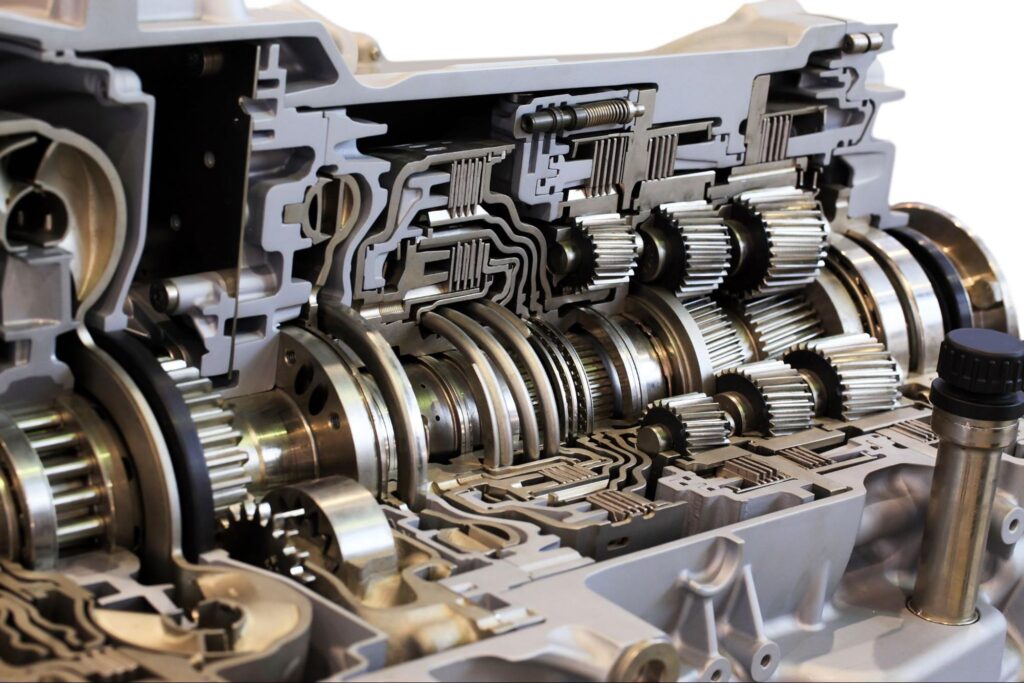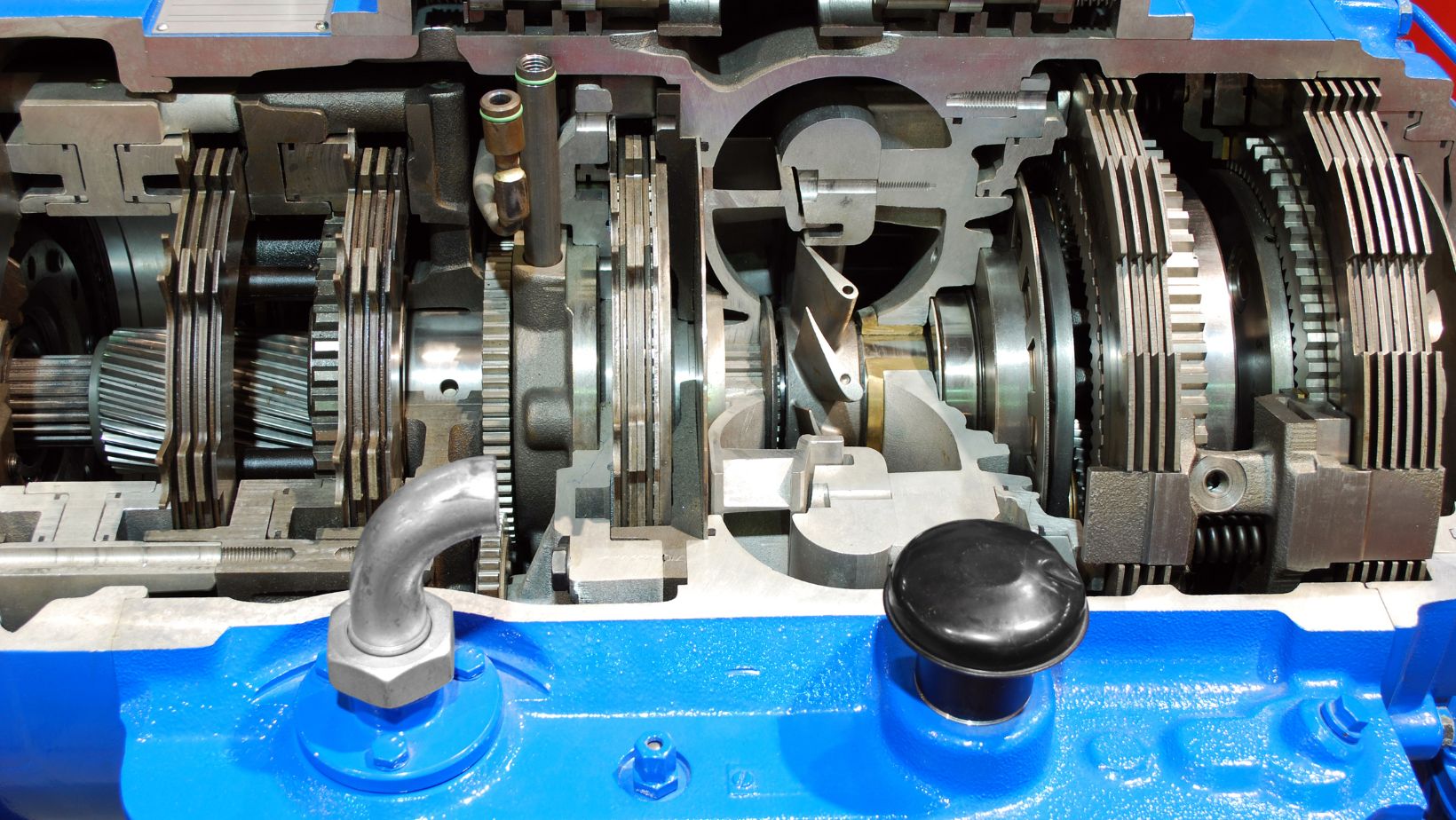
From forklifts to cement mixers, many industrial machines rely on transmissions to transfer engine power to the wheels or work implements. Without them, you ain’t going nowhere!
Getting a basic idea of how different transmission types operate helps in choosing the right rig for various jobs. It also gives insight into proper operation and maintenance.
Let’s lift up the hood and break things down…
Manual Transmissions
The old-fashioned stick shift. One of the simplest options, found mostly in older trucks or specialty equipment.
It uses a hand-operated clutch that temporarily disconnects the engine from the transmission input shaft. It allows smooth shifting between gears by matching their rotating speeds.
Gears then transfer increasing levels of torque from the input shaft to the output shaft coupled to the drive wheels. Lower gears equal higher torque for getting up and going. Higher gears mean less torque but more speed once rolling.
Mastering the friction zone (where the clutch begins engaging) is key for smooth shifting to avoid grinding gears or stalling out. Becomes second nature after practice.
Biggest downside? Constant use of the clutch pedal & gear shifter equals more operator fatigue over long shifts. But provides maximum control and efficiency for experienced drivers.
Automatic Transmissions
True to the name, automatic transmissions shift gears for you based on speed and engine load rather than manual gear changes.
The hydraulic torque converter attachment acts like a fluid coupling instead of a mechanical clutch to transmit power from the engine to the transmission.
It contains:
- Impeller – Attached to engine crankshaft
- Turbine – Spins from impeller action
- Stator – Redirects transmission fluid flow
This fluid drive powers gear changes automatically by planetary gearsets controlled by bands and clutches. No pesky shifting is needed!
The valve body directs transmission fluid to engage the right combinations. Shift progression is adjusted by throttle and governor.
Biggest perk? Way less operator fatigue! Smoother acceleration and deceleration, too. But slightly less efficient and direct feel than manual setups.
Semi-automatic Transmissions
Sometimes, they’re also called automated manuals or clutchless manual transmissions.
Combines characteristics from manuals and automatics for simplicity of no clutch pedal with automated gear shifting.
Uses similar internal gearsets to manual transmissions but is actuated by electronic actuators and circuits instead of direct shifting.
Offers incrementally more control than full automatics while retaining no manual clutch need.
Shifting can be fully automatic or initiated manually by toggle switches, buttons, or paddle shifters. But computer programs prevent over-revving or disconnecting the drive.
Hydrostatic Transmissions
Instead of gears, hydrostatic transmissions rely on pressurized hydraulic fluid to drive motors directly. Allows seamless, infinitely variable speed control.
The main components include:
- Hydraulic pump – Driven by engine
- Hydraulic motor – Powers wheels/implements
Swash plates regulate fluid flow and pressure to determine machine speed and power. No gear shifts are ever needed!
Benefits? Smooth constant power application. Precise slow-speed work capabilities like trenching or lifting. And the simplicity of parts needing service.
Downsides are:
- Lower top speeds.
- Heat buildup issues at high loads.
- Lower efficiency than geared models.
But it’s ideal for niche operating conditions requiring fine control.
Continuously Variable Transmissions
Nicknamed CVT, this type uses pulleys and a belt system rather than gears to provide infinite gear ratios within set limits.
It’s made of:
- 2 adjustable pulleys with inclined discs
- Metal pushing belt
The drive pulley diameter adapts based on throttle position, automatically “shifting” ratios. No preset gears are involved!
Benefits are step-less acceleration, improved fuel efficiency, and fewer components than traditional automatics.
But have less tolerance for high torque situations compared to robust geared transmissions. Still useful for light and medium-duty needs.
Transfer Case Transmissions
These special transmissions build upon primary ones to also power additional drive axles for 4-wheel or 6-wheel drive capabilities.
Contains:
- Extra drive shafts
- Locking differential(s)
- Low range gearset
Locking differentials help equalize torque between wheels to improve traction.

Low-range gears multiply torque for rigorous situations like steep climbing or pulling heavy loads at slow speeds.
Downsides? Added complexity and service needs. But critical for reliably traversing rough terrain on jobsites and extreme conditions.
Transmission Maintenance 101
No matter the transmission type, following basic maintenance best practices, prevents problems down the road:
- Regular fluid changes based on hours used and conditions
- Inspect for leaks and odd noises
- Replace filters per OEM specs
- Consider periodic fluid sampling to monitor wear
- Driveline u-joints and mounts in good shape?
- Keep vent tubes clear of debris
- Test clutch, bands, solenoids, valves
- Check chassis ground straps
Transmission telemetry data gives helpful health snapshots, too.
Investing in quality gear from reputable vendors like https://maurelli.it/ extends transmission lifespan significantly. Avoiding unexpected downtime keeps operations humming smoothly all year long.
Pretty slick how these complex gearboxes transfer massive mechanical muscle in such smart ways, isn’t it? Next time you hop aboard a rig, showing the transmission some appreciation might be in order.














